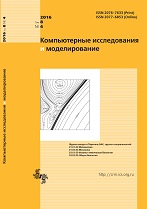|
This article is cited in 2 scientific papers (total in 2 papers)
ANALYSIS AND MODELING OF COMPLEX LIVING SYSTEMS
Analysis of point model of fibrin polymerization
A. A. Andreevaa, A. V. Nikolaevb, A. I. Lobanova
a Moscow Institute of Physics and Technology (state university),
9 Institutskiy lane, Dolgoprudny, Moscow region, 141700, Russia
b The Semenov Institute of Chemical Physics of Russian Academy of Sciences (RAS),
4 Kosygina st., Moscow, 119991, Russia
Abstract:
Functional modeling of blood clotting and fibrin-polymer mesh formation is of a significant value for medical and biophysics applications. Despite the fact of some discrepancies present in simplified functional models their results are of the great interest for the experimental science as a handy tool of the analysis for research planning, data processing and verification. Under conditions of the good correspondence to the experiment functional models can be used as an element of the medical treatment methods and biophysical technologies. The aim of the paper in hand is a modeling of a point system of the fibrin-polymer formation as a multistage polymerization process with a sol–gel transition at the final stage. Complex-value Rosenbroke method of second order (CROS) used for computational experiments. The results of computational experiments are presented and discussed. It was shown that in the physiological range of the model coefficients there is a lag period of approximately 20 seconds between initiation of the reaction and fibrin gel appearance which fits well experimental observations of fibrin polymerization dynamics. The possibility of a number of the consequent ($n = 1-3$) sol–gel transitions demonstrated as well. Such a specific behavior is a consequence of multistage nature of fibrin polymerization process. At the final stage the solution of fibrin oligomers of length 10 can reach a semidilute state, leading to an extremely fast gel formation controlled by oligomer's rotational diffusion. Otherwise, if the semidilute state is not reached the gel formation is controlled by significantly slower process of translational diffusion. Such a duality in the sol–gel transition led authors to necessity of introduction of a switch-function in an equation for fibrin-polymer formation kinetics. Consequent polymerization events can correspond to experimental systems where fibrin mesh formed gets withdrawn from the volume by some physical process like precipitation. The sensitivity analysis of presented system shows that dependence on the first stage polymerization reaction constant is non-trivial.
Keywords:
fibrin, fibrin-polymer, blood clotting, mathematical model, Rosenbroke method (CROS), sensitivity analysis.
Received: 12.10.2016
Revised: 12.12.2016
Accepted: 31.12.2016
Citation:
A. A. Andreeva, A. V. Nikolaev, A. I. Lobanov, “Analysis of point model of fibrin polymerization”, Computer Research and Modeling, 9:2 (2017), 247–258
Linking options:
https://www.mathnet.ru/eng/crm60 https://www.mathnet.ru/eng/crm/v9/i2/p247
|

| Statistics & downloads: |
| Abstract page: | 434 | | Full-text PDF : | 166 | | References: | 64 |
|




 Contact us:
Contact us: Terms of Use
Terms of Use
 Registration to the website
Registration to the website Logotypes
Logotypes









 Citation in format
Citation in format 
